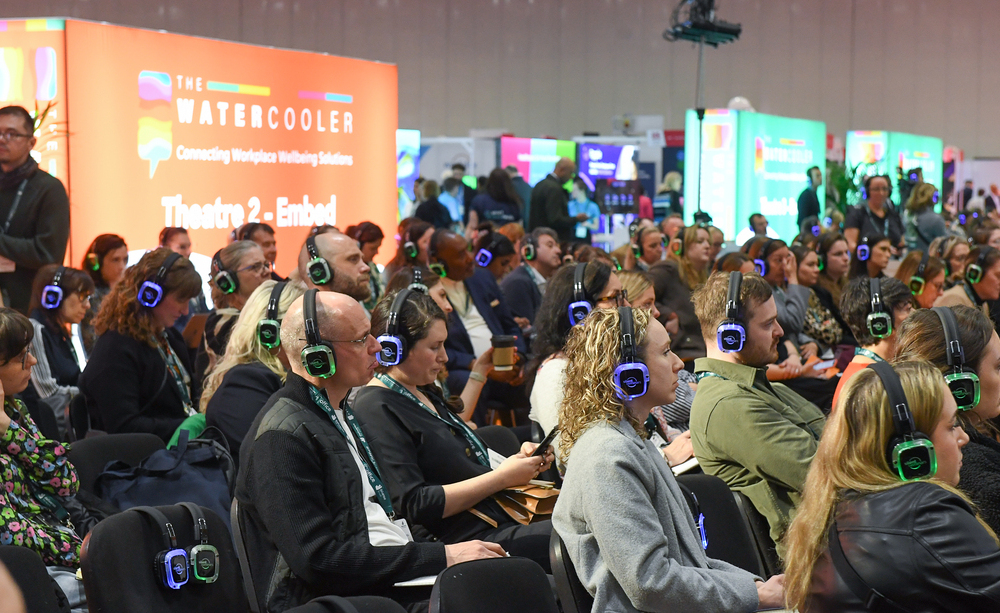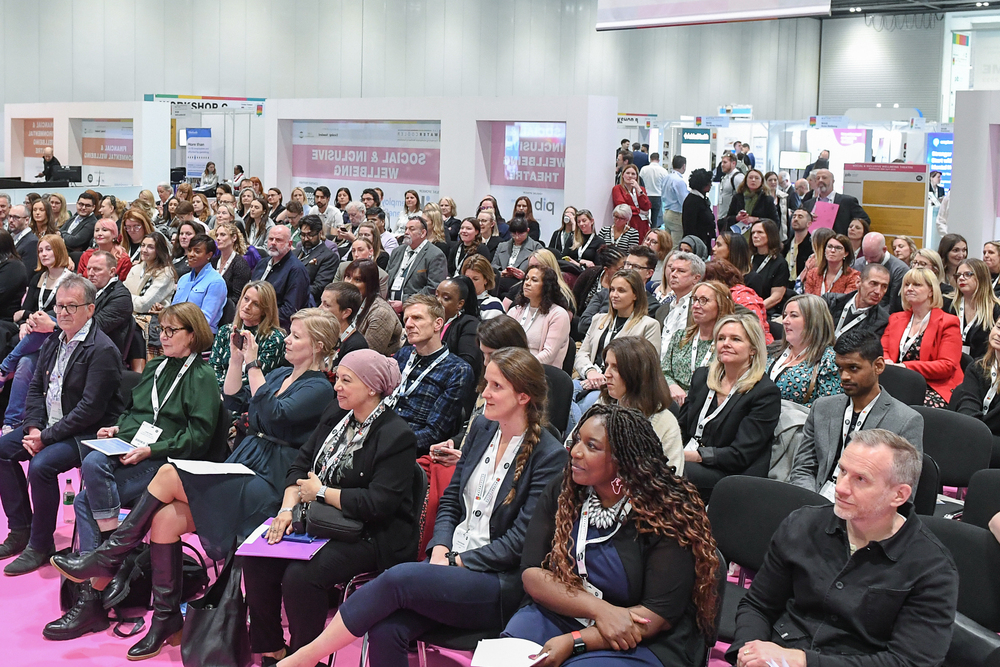Professionals working in the wellbeing industry have been criticised for being too “pink and fluffy” and too much about the “yoga and bananas”, as well as their own lived-experience story and what worked for them, historically. But this year’s Watercooler Event was testament to how much the sector has grown up in the last few years, with the calibre of both speakers and delegates reflecting this change.
People are still as passionate about their cause and their belief that prioritising employee wellbeing is the right thing to do morally, before you even get to the argument about its positive impact on productivity and profitability. However, now, they recognise clearly that passion alone isn’t enough, neither is gut instinct, which is why it was so heartening to see so many tools and research papers launched at the event to prove this passion and that wellbeing works.
Meeting people where they are with wellbeing
It was also heartening to witness their recognition that – while wellbeing’s merit may be obvious to them – they must meet others where they are and make it as easy for the rest of the organisation, to understand exactly why, too.
Some panellists expressed their frustration that some of their colleagues have such a lack of knowledge about wellbeing that they don’t understand simple causal links, such as that overeating leads to obesity and obesity can lead to many serious illnesses. That makes education central to any strategies but, more than that, numbers which prove beyond any doubt that wellbeing does have a tangible impact on the bottom line are essential to any business case today worth its salt.
Wellbeing proven to have bigger impact than thought
The big news with regards to proof, as revealed at the Watercooler, is that we all knew that wellbeing was important and had an impact but the “size of the prize” has now been proven to be “so much bigger than previously thought”.
These are the words of Barbara Jeffery, Partner, McKinsey and Affiliate partner with McKinsey Health Institute, who unveiled the new research paper entitled ‘Prioritize People: Unlock the value of a thriving workforce”. She did this while speaking on a panel, facilitated by Heathrow Airport’s CFO Javier Echave, on “Redefining Success: The compelling case for putting thriving people at the heart of business strategy”.
The stats are powerful
The research, commissioned by Business in the Community, and conducted also in partnership with Oxford’s Wellbeing Research Centre & a group of UK CFOs, comes to its conclusions by analysing data on absenteeism, attrition, presenteeism, productivity, retention and attraction. And the conclusions are impressive, powerful arguments for anyone wanting to make a business case for wellbeing:
- the UK economic value of improved employee wellbeing could be between £130-370 billion per year or 6-17% of the UK’s Gross Domestic Product. This is the equivalent of £4,000-£12,000 per UK employee
- Addressing attrition could lead to a £12-36 billion increase to the economy;
- Reducing absenteeism could lead to £4b
- Reducing presenteeism and improving productivity could lead to £85-288bn
- Boosting retention could lead to £15-24bn
- Increasing attraction (employer brand) could lead to a £13bn increase to the economy
Wellbeing attracting significant investment
Jeffery added that the fact that the wellbeing industry is now attracting significant investment is also a sign it has come of age and is being taken seriously. “And they want to invest in the ‘S’ as well as the ‘G’ in ESG,” she said.
At the same time, McKinsey launched its new, free resources to support employee wellbeing, most usefully an assessment tool which measures employee needs. It then evaluates how the workplace is impacting their health to help employers identify the best opportunities to support them in a sustainable way. You can find this here.
‘This puts numbers to instinct’
Becky Corris, Head of Health & Wellbeing, Heathrow Airport, who was also on the panel, and has used the tool already, said:
“We can’t make a case based on intangibles and gut instinct. The McKinsey research puts numbers to what we all knew instinctively. And the tool arms you with information to have a conversation with your broader team and show them that you’re going after the same thing so you can collectively define a plan.”
Throughout The Watercooler, the question of how you measure systemic change in an organisation came up repeatedly. Corris’s reply to this was that you have to measure constantly and consistently – alluding again to the tool being one which is designed to be used repeatedly so you can measure change.
Measurement must be scalable and purpose-led
When considering tools to use, she cautioned delegates that:
“Any tool must be scaleable and have a purpose. Measuring the wrong thing is more dangerous than not measuring at all!”
Dame Carol Black had a similar message, but even more cautionary when it came to introducing interventions without a clear measurement strategy before and behind them:
“There is little evidence that any of these things [wellbeing interventions] work. They don’t have trials or science behind them. Employers need to test interventions in the workplace. The growth of unscientific, unproven interventions may not do any good.”
Growing number of tools
But, while there may be many unproven interventions flooding the marketplace, there are also a growing number of useful measurement tools, many of which were launched and talked about at the Watercooler.
For example, the CCLA’s new Corporate Mental Health Benchmark tool for responsible investors, won our Award for “Game-changing initiative of the year that promises to really move the dial on workplace mental health and wellbeing”.
As our Partner & Global Director of Content at Make A Difference Events & Media, and The Watercooler, Claire Farrow, explained:
“It’s a fantastic initiative to help maintain momentum and really embed mental health and wellbeing as a priority across organisations. It evaluates how the world’s largest listed companies are approaching and managing workplace mental health. We believe that this initiative will provide a sense of accountability that will help companies create conditions in which employees can really thrive.”
Similarly, GoodShape launched an Absence Calculator, which reveals not only the direct costs of absence to organisations, such as lost working time and replacement worker fees, but also the hidden costs of poor workforce wellbeing that organisations often overlook. See here for more info.
All these tools and credible research studies serve to distance the wellbeing industry even further from the ‘fluffy’ tag of old, and move it away from purely reactive interventions randomly implemented, towards preventative, evidence-based strategies.
Nevertheless, as Ryan Hopkins, Deloitte’s Future of Wellbeing Lead, called out in his session on “Digital Balance”, that not enough employers are currently measuring wellbeing properly and, until they do, “wellbeing will continue to be treated as something on the side”. “It needs to become a science to get the respect it needs,” he said during his panel. So, professions need to start embracing and consistently using measurement tools.
Hopefully, as in line with our mission at Make A Difference Media, the Watercooler will have brought more employers to the conversation, and more professionals to understand the vital importance of measuring the impact of wellbeing and, practically, how they can.

















